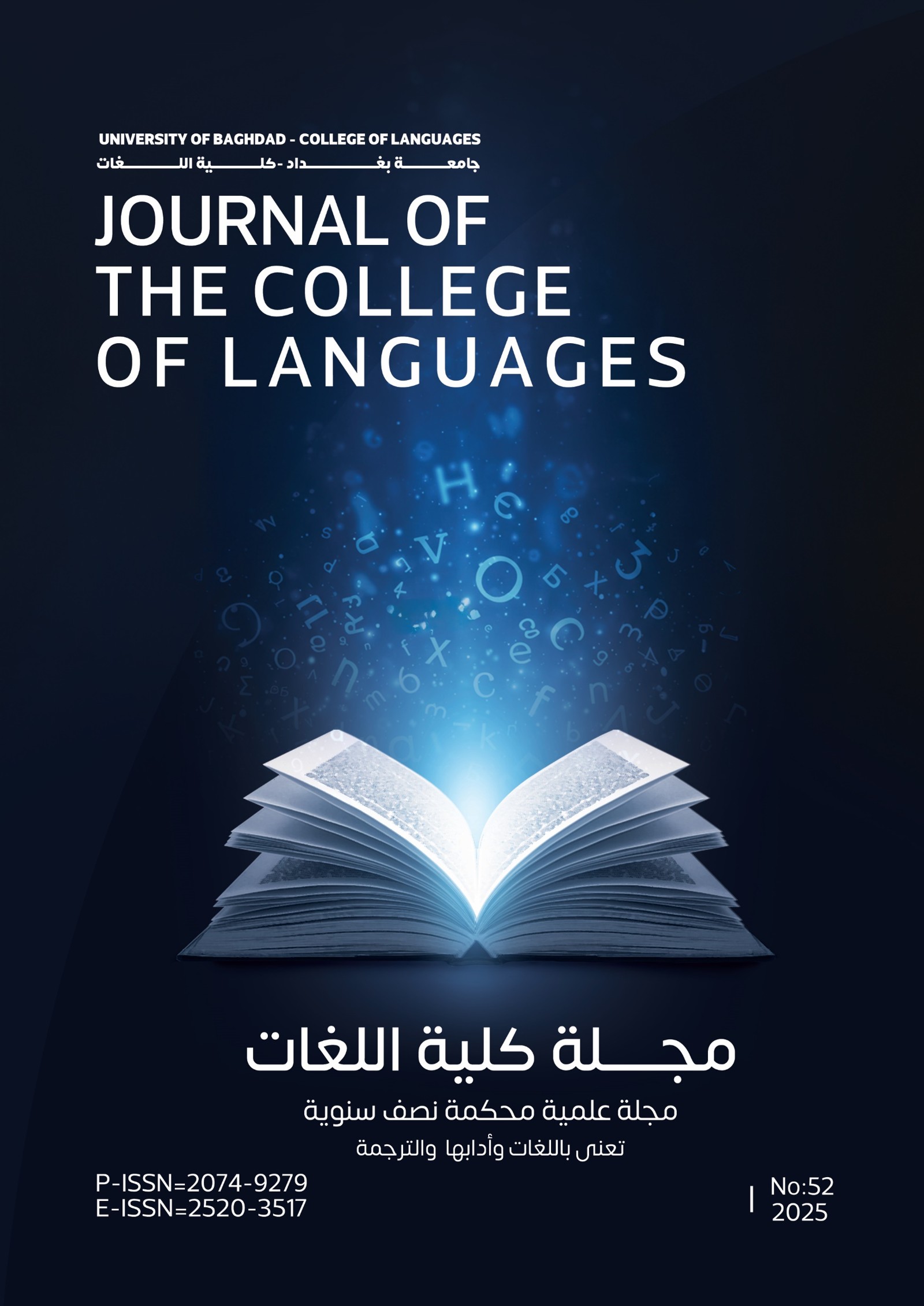Word-Formation Motivation of Diminutive Vocabulary in Russian and Arabic
Словообразовательная мотивация диминутивной лексики в русском и арабском языках
DOI:
https://doi.org/10.36586/jcl.2.2023.0.47.0220Keywords:
word-formation motivation, diminutive vocabulary, Russian, Arabic, root and formant.Abstract
The question of word–formation motivation is one of the most urgent problems of morphological features of diminutive vocabulary in the languages of different structures, Arabic – Semitic and Russian - Slavic. The relevance of this question lies in the fact that the analysis of morphological elements of word-formation motivation plays an important role not only in identifying formal and semantic connections between different units of the same language, but also has an applied value in the comparative study of different languages. Taking in to account that word-formation motivation is usually considered sequentially in order to identify motivational relationships of this type of vocabulary, we will study motivation in comparative analysis on the material of diminutive vocabulary of different languages. We will analytically approach the important question of the practical application of translation basics in achieving translation adequacy.
Аннотация
Вопрос о словообразовательной мотивации является одной из актуальных проблем, связанных с морфологическими особенностями диминутивной лексики в разноструктурных языках: арабском – семитском и русском – славянском. Анализ морфологических элементов словообразовательной мотивации играет большую роль не только в выявлении формально-семантических связей между разными единицами одного языка, но и имеет прикладное значение при сравнительном изучении разных языков. Учитывая, что словообразовательная мотивация, как правило, изучается последовательно, в рамках данного исследования рассмотрим ее на основе сравнительного анализа диминутивной лексики разных языков в целях выявления мотивационных отношений данного типа лексики, а также предпримем попытку аналитического подхода к вопросу о практическом применении переводческих основ при достижении адекватности перевода.
References
Belkin V. M. (1975). Arabskayaleksikologiya. Moskva: Izd-voMosk. un-ta.
Belyaeva M. YU. (2017). Uzual'no-okkazional'nyeslovoobrazovatel'nyegnezda s vershinami-zoonimami. Teoriyaipraktikaonomasticheskihiderivatologicheskihissledovanij, 380-397.
Vinokur G. O. (1959). Zametkiporusskomuslovoobrazovaniyu. Izbrannyerabotyporusskomuyazyku. Uchpedgiz, 419 - 442.
Zemskaya E.A. (1989). Slovoobrazovanie // Sovremennyjrusskijyazyk: ucheb. dlyafilol. spec. un-tov. 2-e izd.,ispr. i dop. Moskva: Vysshayashkola.
Zubova L.V., Men'shikova YU.V. (2014). Morfemikaislovoobrazovaniesovremennogorusskogoyazyka. SPb: Filologicheskijfakul'tetSPbGU.
Karam, R. A. (2011). Semanticheskaya klassifikaciya osnovnyh tipov slovoobrazovatel'noj metafory. Journal of the College of Languages (JCL), (23), 20-29.
Klobukov E.V. (2009) Slovoobrazovanie // Sovremennyjrusskijliteraturnyjyazyk. Uchebnik / Pod red. P.A. Lekanta. Moskva: Vysshayashkola.
Raciburskaya L. V., &Sorokina, M. V. (2004). O tipologiislovoobrazovatel'nyhmotivacij (naprimereslovoobrazovatel'nyhcepej so slovamiedinichnojstruktury). Filologicheskieissledovaniya: sbornikstatejmolodyhuchenyh. N. Novgorod: NNGU, 193-198.
Tashlykova M. (1999). Russkoeslovo v svetestrukturno-semanticheskogoopisaniya (slovoobrazovatel'nyjimorfemnyjanaliz). Irkutsk: Irkutskijgos. Un-t.
Uluhanov I.S. (1977). Slovoobrazovatel'nayasemantika v russkomyazykeiprincipyeeopisaniya. Moskva: Moskva: Nauka.
Uluhanov I. S. (1971). Slovoobrazovatel'nayamotivaciyaieevidy. Izv. AN SSSR. Seriya lit. iyaz, 30(1), 37-46.
Uluhanov I. S. (2005). Motivaciya v slovoobrazovatel'nojsistemerusskogoyazyka. Moskva: Obshchestvo s ogranichennojotvetstvennost'yu" Izdatel'skijcentr" Azbukovnik".
Uluhanov, I. S. (2015). Glagol'noeslovoobrazovaniesovremennogorusskogoyazyka: Glagoly, motivirovannyeimenamiimezhdometyaii. Moskva: Azbukovnik.
Fortunatov F.F. (2010). Sravnitel'noeyazykovedenie. Moskva: Krasad.
Hodunova T. N. (2010). Slovoobrazovatel'noegnezdo s vershinoj ‘dvigat'’: istoriyaisovremennoesostoyanie. Moskva: AKD.
SHvedova N. YU. (1980). Russkayagrammatika, Tom I, Fonetika, fonologiya, udarenie, intonaciya, slovoobrazovanie, morfologiya. Moskva: Nauka.
YArceva V. N. (1998). YAzykoznanie. Bol'shojenciklopedicheskijslovar'. Moskva: Bol'shayaRossijskayaenciklopediya.
Al-Foadi R. A.,&Mingazova N. G. (2018). The three-level phono-grammar order and its derivational connecting link: The elements of language system (on the material of Arabic). XLinguae, 11(4), 59-77.
Al-Foadi R. A., Zarytovskaya V. N., & Al-Roznamachi R. H. (2021). Motivation of Word Formation in Russian and Arabic Languages and its Role in Achieving Translation Equivalence. RUDN Journal of Language Studies, Semiotics and Semantics, 12(3), 652-668.
Al-Roznamachi, R. H., & Al-Foadi, R. A. (2022). Word-Formation System and Its Influence on the Translation of New Vocabulary in Russian and Arabic. Journal of the College of Languages (JCL), (45), 210–232.
Ibn Faris (1979). Dictionary of Language Standards. Jordan: Dar Al-Fikr. (In Arab.).
Jabal M.H. (2006). The theoretical and practical derivation. Cairo: Literature Library. (In Arab.).
Mubarak M. (2005). Philology and characteristics of Arabic. Lebanon: Dar Al-Fikr.
Neme A. A.,&Laporte E. (2013). Pattern-and-root inflectional morphology: the Arabic broken plural. Language Sciences, 40, 221-250.
Downloads
Published
Issue
Section
License
Copyright (c) 2022 Journal of the College of Languages (JCL)

This work is licensed under a Creative Commons Attribution 4.0 International License.








